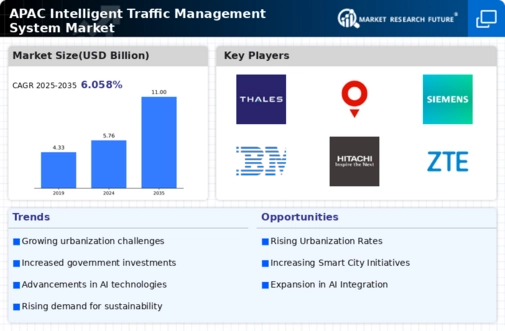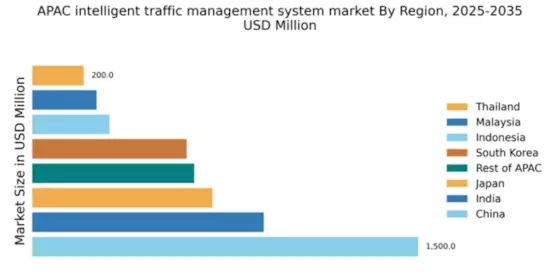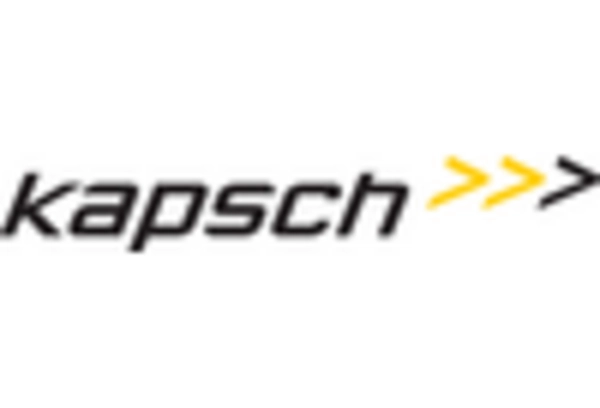China : China's Dominance in Traffic Management
China holds a commanding market share of 37.5% in the intelligent traffic-management-system sector, valued at $1500.0 million. Key growth drivers include rapid urbanization, increasing vehicle ownership, and government initiatives aimed at smart city development. Demand trends show a shift towards integrated traffic solutions, supported by regulatory policies promoting sustainable transport. Infrastructure investments, particularly in major cities, are enhancing the industrial landscape, fostering innovation in traffic management technologies.
India : India's Expanding Urban Mobility Needs
India's market share stands at 22.5%, valued at $900.0 million, driven by urbanization and increasing traffic congestion. The government is actively promoting smart transportation initiatives, including the Smart Cities Mission, which encourages the adoption of intelligent traffic systems. Demand is rising for real-time traffic management solutions, with a focus on enhancing public transport efficiency and safety. Infrastructure development, particularly in metropolitan areas, is crucial for market growth.
Japan : Japan's Technological Edge in Mobility
Japan accounts for 17.5% of the market, valued at $700.0 million, with growth fueled by advanced technology adoption and a strong focus on safety. The government supports intelligent transport systems through initiatives like the Intelligent Transport System (ITS) program, promoting seamless mobility. Demand for smart traffic solutions is increasing, particularly in urban centers like Tokyo and Osaka, where congestion is a significant issue. Infrastructure investments are enhancing the competitive landscape.
South Korea : South Korea's Commitment to Innovation
South Korea holds a market share of 15%, valued at $600.0 million, driven by government policies promoting smart city initiatives and advanced traffic management systems. The demand for integrated solutions is growing, particularly in cities like Seoul and Busan, where traffic congestion is a pressing concern. Major players like Siemens and Cisco Systems are actively involved in the market, contributing to a competitive landscape focused on innovation and efficiency.
Malaysia : Malaysia's Growing Urban Infrastructure
Malaysia's market share is 6.25%, valued at $250.0 million, with growth driven by urbanization and government initiatives aimed at improving traffic management. The demand for intelligent traffic systems is increasing, particularly in Kuala Lumpur, where congestion is a challenge. The government is investing in smart city projects, creating opportunities for local and international players. The competitive landscape includes both established firms and emerging local companies.
Thailand : Thailand's Focus on Urban Mobility
Thailand's market share is 5%, valued at $200.0 million, with growth driven by urbanization and increasing vehicle ownership. The government is promoting smart traffic management through initiatives like the Smart City Development Plan. Demand for intelligent systems is rising, particularly in Bangkok, where traffic congestion is a major issue. The competitive landscape features both local and international players, focusing on innovative solutions to enhance urban mobility.
Indonesia : Indonesia's Urban Mobility Challenges
Indonesia holds a market share of 7.5%, valued at $300.0 million, driven by rapid urbanization and increasing traffic congestion in cities like Jakarta. The government is implementing smart city initiatives to improve traffic management and reduce congestion. Demand for intelligent traffic systems is on the rise, with a focus on enhancing public transport efficiency. The competitive landscape includes both local firms and international players, fostering innovation in the sector.
Rest of APAC : Emerging Markets in APAC
The Rest of APAC accounts for a market share of 15.75%, valued at $630.0 million, with growth driven by varying urbanization rates and government initiatives across different countries. Demand for intelligent traffic systems is increasing, particularly in emerging markets where infrastructure development is a priority. The competitive landscape is diverse, with both local and international players vying for market share, focusing on tailored solutions for specific regional needs.


















Leave a Comment